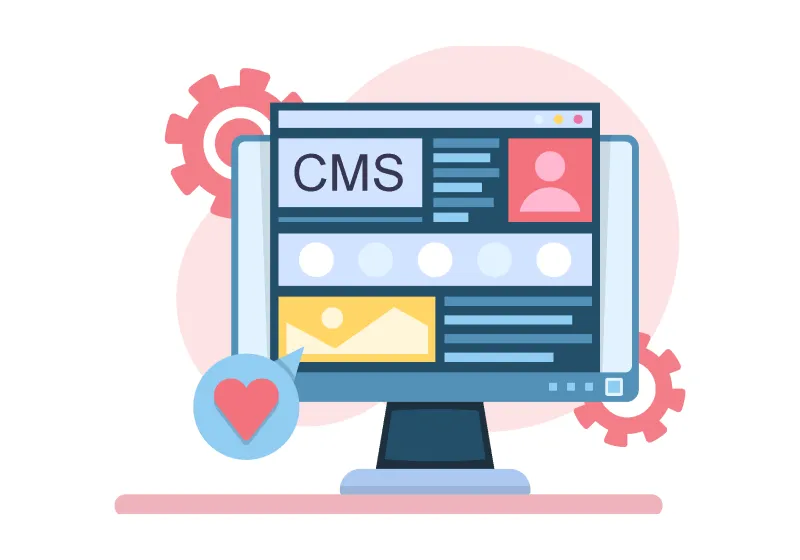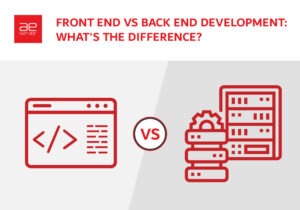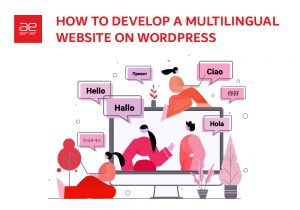Utilizing Content Management Systems (CMS) is fundamental in web design. CMS empowers designers to create dynamic, interactive websites. Here, we explore diverse CMS types and exemplify their effectiveness.
1. Proprietary CMS. This type results in tailor-made solutions, but costs can be excessive. Examples comprise Adobe Experience Manager and Sitecore.
2. Open-Source CMS: These gems provide adaptability and cost-efficiency. WordPress and Joomla exemplify this category with assurance.
3. Headless CMS: This progressive variant detaches the front end from the back end. Strapi and Contentful exemplify its innovation.
4. Decoupled CMS: This CMS design separates the front end and back end for enhanced performance. Notable instances encompass Drupal and ButterCMS.
5. Static Site Generators: These nimble CMS produce pre-rendered web pages. Noteworthy specimens encompass Gatsby and Hugo.
Each CMS kind proffers its unique merits, contingent upon the project’s needs. Proprietary systems furnish unmatched customization, whereas open-source solutions offer cost-effective versatility. Headless CMS stands at the vanguard of innovation, while decoupled CMS enhances performance. Finally, static site generators deliver rapid, pre-rendered pages. CMS, the architect of web design, ushers in an era of autonomous content management.
When navigating the intricate labyrinth of web design, selecting the optimal CMS is essential. Evaluate the project’s demands, budget, and performance before starting the digital journey.

Table of Contents
What is a Content Management System (CMS)?
The term “Content Management System” (CMS) frequently emerges in web design. But what is this vital instrument that underpins virtual landscapes?- Defining CMS: A CMS is a digital infrastructure granting control over website content. It empowers users to manipulate text, images, and multimedia with ease.
- The Active Role: CMS enforces dynamic control, enabling instantaneous content updates.
- Content Modules: Intricately modular, CMS fragments content into manageable elements.
- User Empowerment: CMS cultivates autonomy, reducing reliance on developers.
- Customization Flexibility: Tailoring aesthetics and functionality, CMS adapts to diverse demands.
- Intricate Structure: Behind the scenes, databases and frameworks coordinate content presentation.
- Benefits of CMS: Enhanced efficiency, real-time alterations, and seamless content integration.
- Web Designer’s Ally: CMS empowers designers to craft compelling, ever-evolving websites.

Types of CMS
Many Content Management Systems exist, each customized for specific needs. The platforms cater to diverse design requirements, underscoring their versatility. Exploring the myriad of distinct CMS types constituting the bedrock of design undertakings is imperative. Each discrete CMS classification is tuned to specific design requisites. The selection of a CMS depends on the project requirements and performance benchmarks. It’s a multifaceted decision that necessitates a meticulous evaluation of these factors. Identifying the CMS design system that resonates with your visionary objectives is essential. This alignment with the suitable CMS is pivotal for realizing your design aspirations. The following analysis of CMS systems highlights their role in digital environments. It accentuates the significance of these systems in creating ever-evolving digital landscapes. A designer comprehending these CMS intricacies can align with the desired functional opulence.Headless CMS Systems
The Headless CMS design system is a cutting-edge choice, separating content from presentation. It empowers designers with unmatched adaptability in crafting digital experiences. Designers employ this innovation to craft diverse digital interactions. The separation facilitates adjustments without the need to reconfigure the presentation layer. This streamlines the design process and allows for swift content updates. It dynamically empowers creators to adapt and refine digital content, enhancing user experiences. It empowers the constructing of multifaceted digital environments that cater to various user needs. The potent combination of content and presentation layers allows content updates, providing improvements.Decoupled CMS Systems
Decoupled CMS liberates front-end and back-end, boosting flexibility and performance. It unravels content and presentation, enabling tailored optimization for a dynamic digital presence. This duality elevates content efficiency and expands creative possibilities, encouraging sophistication. CMS pioneers digital landscapes, marking a design paradigm shift and technological innovation.Open-Source CMS Systems
Designers prefer open-source CMS like WordPress for adaptability and abundant plugins. These systems supply designers with customization to align with project specifications. Open-source CMS web design platforms, by their very nature, ease a dynamic and adaptable approach to web design. The library is a toolbox optimizing the web environment to suit creators’ needs.Proprietary CMS Systems
Content Management Systems of the kind of Adobe Experience Manager and Sitecore indisputably dominate the domain of their inclination for exclusive and bespoke solutions. While it is true that their acquisition comes at a premium, these CMS systems allow a depth of customization and refinement. Such systems cater to the most discerning clientele and their intricate project requisites. Their supremacy in the CMS landscape is a testament to their ability to grant spotless, tailored solutions that align perfectly with their users’ exacting standards and unique demands. Even though this level of excellence may entail a corresponding investment. CMS systems such as Adobe Experience Manager and Sitecore reign supreme for exclusive solutions, reflecting the intricate nature of CMS in website development.Static Site Generators
Efficient static site generators like Gatsby and Hugo pre-render web pages, ensuring rapid loading. These generators are a valuable choice for web creators seeking top-notch performance. The choice of a CMS system is pivotal in the design journey. Headless CMS and decoupled CMS are trailblazers in content management innovation. Open-source systems, on the other hand, offer cost-effective flexibility. Closed systems deliver customized solutions and static site generators emphasize performance and security.Web Design with CMS
The digital realm is growing, demanding cutting-edge solutions. Enter Website Design and Content Management Systems (CMS). A fundamental change, not temporary but enduring. Website design, aesthetics, and structure twines seamlessly with a Content Management System. CMS, a labyrinth of functionality, empowers with elegance. Unshackle your web’s potential with:- Streamlined Customization Website design, coupled with CMS, offers personalized expertise. Tailoring your digital expanse, not compromising aesthetics.
- Magnetic User Experience CMS enhances fluidity. Website design magnetizes visitors, inducing retention and allure.
- Effortless Updates Through CMS, transcendence unfolds. Effortlessly update your web’s essence. No shackles of coding are required.
- CMS harmonized with Data Website design, interwoven with CMS, harmonizes with data. A data-centric approach ensures your web’s success.
- Efficiency Amplified CMS’s operational insight and the design’s visual finesse synergize. Efficiency is the hallmark.
- Dynamic Collaboration CMS fosters collaboration. Team up without hassle. Strengthening your digital fortress.
- Sustainable Elevation
Designing with WordPress
The CMS, a typical architect, coordinates your digital space. It empowers creators to sculpt their online identity. Effortless content creation ensues, tailored to your vision. Customization expands, and unique style flourishes. A workable framework, unrivaled in the digital sphere. Themes, an artist’s palette, imbue your site with personality. Limitless aesthetics breed a distinctive presence. Your brand prospers, distinct from the monotonous crowd. Plugins, akin to digital craftsmen, enhance functionality. Elevate user experience and streamline interaction. Robust performance emerges with every activation. Effective WordPress management is crucial for maintaining a secure and high-performing website. WordPress’s responsive design nucleus caters to mobile viewers. A seamless cross-device experience is non-negotiable in the contemporary digital terrain. Content management, WordPress’s strength, ensures your digital ensemble remains harmonious. Organize, edit, and fine-tune your compositions with ease. WordPress stands out as a dynamic catalyst in CMS system design.Creating with Headless CMS
Headless CMS separates content from presentation, enabling developers to create tailored user experiences. This decoupling results in dynamic, content-neutral interfaces that adapt to various platforms. It fosters adaptability across diverse devices and enriches the user experience. The fundamental principle governing Headless CMS is its API-driven structure. APIs act as intermediaries, furnishing content to various endpoints. This dynamic interaction enables a modular, scalable, and customizable approach. Web designers now face an expansive and unconstrained canvas. The power to curate content from design empowers the creation of unique and personalized interfaces. The result is a convergence of aesthetics and functionality, enriching user interaction. Headless CMS transcends usual web design, helping designers create engaging digital experiences. Embrace this revolution to unlock the true potential of your web creations.CMS and SEO
In web design, the synergy between Content Management Systems (CMS) and Search Engine Optimization (SEO) is pivotal. The active alignment of these entities elevates the digital landscape. CMS plays a classic role in content structuring, enabling seamless organization. With strategic SEO integration, this structured content elevates web visibility and search rankings. Efficient CMS allows rapid content updates, assuring the freshness search engines crave. SEO-enhanced meta tags, headers, and keyword optimization amplify content visibility. Active, content-rich URLs strengthen SEO, cultivating a harmonious relationship. Enhanced internal linking and sitemaps expedite indexing. Responsive design complements SEO by ensuring device compatibility enriching the user experience. The connection between CMS and SEO is the bedrock of elevated web design content management. They fuel digital visibility and user engagement, elevating your web presence in the digital realm.Conclusion
In website development, Content Management Systems (CMS) are pivotal in shaping digital landscapes. Active CMS empowers content organization, enhancing user experience and ease of access. Content-driven websites thrive and with SEO integration, visibility surges, benefiting online presence. Robust CMS ensures rapid updates, keeping the site fresh and enticing search engines and users alike. Responsive design, an essential facet, heightens cross-device compatibility, boosting user engagement. CMS is the linchpin, fostering dynamic, user-friendly websites. The symbiosis of CMS in website development is transformative, molding digital realms. It streamlines content management, enriches SEO, and elevates user engagement. Responsive design underscores the importance of crafting adaptable, user-centric interfaces. CMS is a cornerstone of contemporary web development, facilitating dynamic digital landscapes.FAQ
A CMS is a digital framework for managing and delivering web content.
It streamlines content organization, enhancing user experience and SEO integration.
Responsive design ensures cross-device compatibility, optimizing user engagement.
Rapid content updates and SEO-rich elements for enhanced visibility and freshness.
It forms the foundation, shaping dynamic, user-centric digital landscapes.
CMS empowers content organization, which improves user experience and access.





